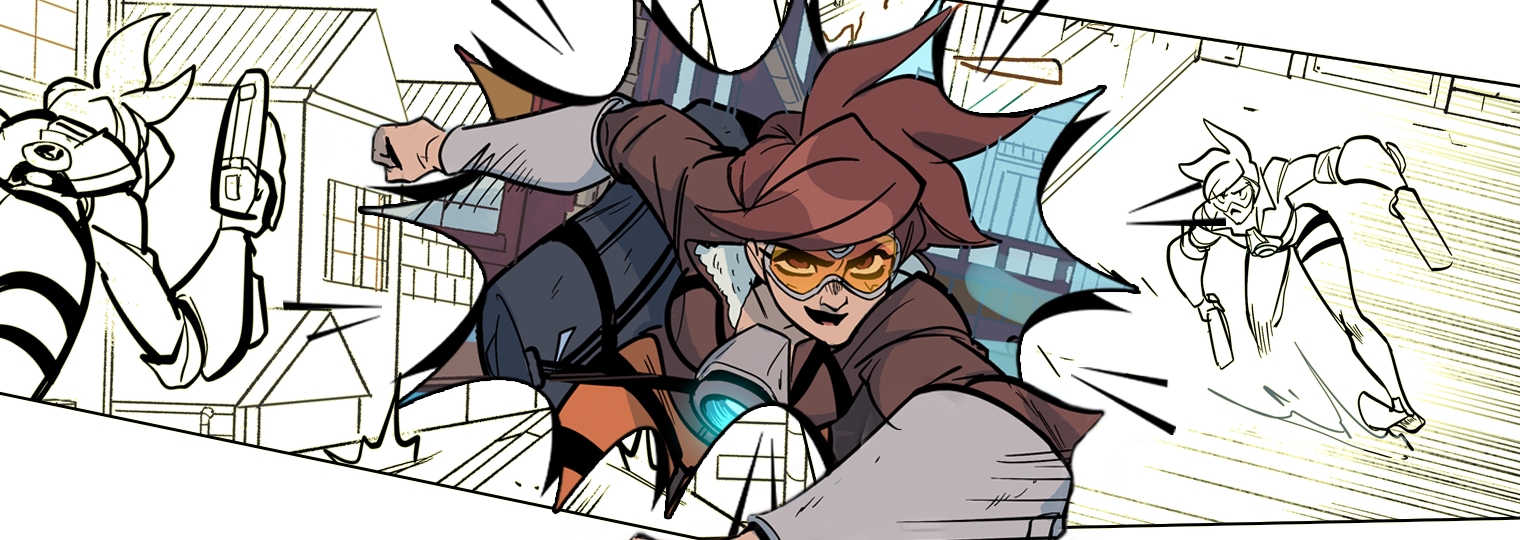
Soldiers. Scientists. Adventurers. Oddities.
At its core, the story of Overwatch is one of heroes. Individuals from globe-spanning walks of life bonded by their belief in a better future for the world they inhabit. And there’s no better time to delve into the past of a hero familiar to all as the game’s poster girl than with the release of her titular comic, Tracer: London Calling. Before you dive into issue #2, discover more about how this iconic Overwatch character became who she is today.
FROM TEST PILOT TO TIME-JUMPER
The youngest member ever inducted into Overwatch’s experimental flight program, Lena Oxton—callsign: “Tracer”—was a hotshot pilot known for her fearless flying skills and upbeat attitude and the first to test the prototype of the cutting-edge teleporting fighter jet, the OWX-01 Slipstream. However, on the Slipstream’s inaugural flight, the jet’s teleportation matrix malfunctioned, and Oxton found herself a victim of time’s whims, vanishing entirely.
Hours, then days, then weeks passed. With neither trace of life nor contact from Oxton, the Slipstream was presumed destroyed, and its pilot presumed deceased. When Oxton miraculously reappeared months after the incident, Winston, the resident intelligent, genetically engineered gorilla scientist working for Overwatch, sought to engineer a means to anchor her. His efforts led to the creation of the chronal accelerator, a device that allowed Oxton to remain tied to the present, counteracting the chronal disassociation that had desynchronized her molecules from the flow of time. The accelerator became the core of Oxton’s being; it kept her body wholly tethered to her timeline, while also allowing her to speed up and slow down time at will for fleeting moments.
After the incident, Oxton entered formal training to become an Overwatch agent. Jack Morrison, the idealistic leader of the organization, was impressed by Oxton’s skill set and determination and dispatched her an unauthorized mission—her very first. There, Oxton aided a strike team comprised of Dr. Angela “Mercy” Ziegler, Torbjörn Lindholm, and Reinhardt Wilhelm to quell an uprising, led by the omnic separatist group Null Sector, on the streets of London. Together, they successfully liberated the city.
In the years that followed, Oxton served as a core member of various strike teams, carrying out a slew of missions including the apprehension of the terrorist organization Talon’s devious financier, Maximilien, in Havana, and the defeat and capture of Doomfist in Singapore.
After the passing of the Petras Act and the subsequent sunsetting of Overwatch operations, Oxton, not wanting to be bound by the mundanity of a Royal Airforce desk job, struck out on her own. She began a new life back in her home city of London with her girlfriend, Emily, and became a vigilante hero, righting wrongs and combatting injustices on a smaller scale.
Now, as recounted in the comic London Calling, Lena Oxton is drawn once more into the fray. Years after Overwatch has been disbanded, the world finds itself beset by injustice and vulnerable to self-interested powers. In some places, Omnics still struggle in the decades since the Omnic Crisis, demanding equality and an end to discrimination against their kind. The world needs heroes again, and heroes often come from unexpected places.
Oxton has befriended Iggy, an omnic who shares her love of music. After visiting Iggy’s home in the Underworld, where most of London’s omnic population struggles to survive in harsh conditions, Oxton has vowed to help Iggy repair the Grid, the Underworld’s source of power. But in doing so, she’s attracted the attention of the omnic Kace and his followers, who believe nothing good can come from humans.
THE JUMP TO TRACER
As the earliest hero created for Overwatch, Tracer became a prototype of sorts for the game’s other characters and was inspired by the Jumper, a class from Project Titan that possessed Blink and Recall abilities familiar to Tracer players today. When development on Overwatch began, the team made a conscious effort to move away from the class-based structure of their game’s predecessor and create heroes with personality, depth, and backstories instead. From the vestiges of the Jumper class, the first Overwatch hero arose. No longer was she merely something; she had become someone. She had become Tracer—the embodiment of hope and optimism in the futuristic world of Overwatch.
With Tracer’s inception came a cavalcade of iteration on her looks and abilities, each round bringing her closer to her current state. While many of her abilities were carried over from the Jumper, her core ability—the Pulse Bomb—was originally a bomb that froze players in a slice of time. The ability fit her time-jumping hero thematic, but it didn’t quite function how the team envisioned it in-game, and was ultimately revamped to her current damage-based Pulse Bomb.
Along with her ultimate, Tracer’s design metamorphosed as development on Overwatch continued. Her backstory became the core of her concept development, and to keep her design in-line with her history as a test pilot, artists incorporated several key elements into each different concept: a bomber jacket, scarf, and aviator goggles. While her current design features a brown retro-style bomber accented by striking neon leggings, an orange-tinted visor, and her signature spiked updo, past design iterations featured more muted colors, many different hairstyles, and, most notably, a long scarf that would flow behind her as she darted around the map. The scarf was scrapped in favor of a sleeker design, but the idea remained in the form of the bright blue energy ribbon that trails after her in-game today.
Now that you’ve learned more about Tracer, you can follow her story in London Calling, written by award-winning author Mariko Tamaki and illustrated by celebrated artist Babs Tarr, and read the digital versions of issues #1 and #2 now!